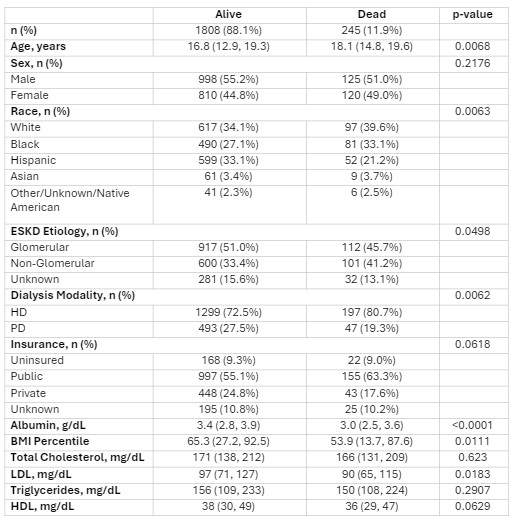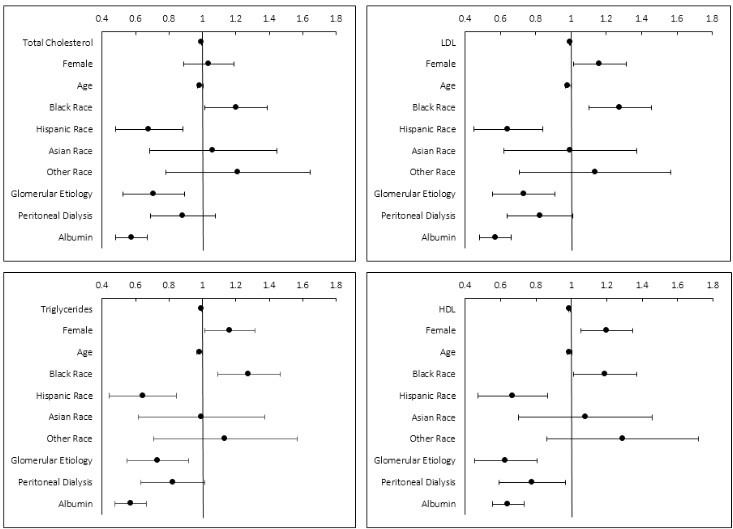Nephrology 6
Session: Nephrology 6
633 - Lipid Levels and Mortality in the Pediatric Dialysis Population
Sunday, April 27, 2025
8:30am - 10:45am HST
Publication Number: 633.5793
Edward Zitnik, University of Connecticut School of Medicine, West Hartford, CT, United States; marciana laster, Indiana University, Indianapolis, IN, United States

Edward Zitnik, DO (he/him/his)
Pediatric Nephrologist
University of Connecticut School of Medicine
West Hartford, Connecticut, United States
Presenting Author(s)
Background: Children on dialysis have a 10-fold higher cardiovascular disease (CVD) mortality when compared to healthy children. While the prevalence of dyslipidemia in this population has been described, it is not known how abnormal lipid profiles influence mortality in pediatric patients on dialysis.
Objective: To identify how Total Cholesterol, LDL, Triglycerides, and HDL influence all-cause mortality in pediatric patients on dialysis.
Design/Methods: This is a study of 2051 USRDS pediatric patients (≤21 years) incident to maintenance hemodialysis (HD) or peritoneal dialysis (PD) between 2001 and 2016. Cox proportional hazard regression models were performed to determine the influence of lipid levels on all-cause mortality. The models were controlled for age, sex, race, etiology of ESKD, dialysis modality, and serum albumin.
Results: 245 (11.9%) of the cohort died during the period of study. Patients who died had a statistically lower LDL than patients who survived with median LDL of 90 mg/dL and 97 mg/dL respectively, p = 0.018. Patients who died also had lower serum albumin and BMI percentiles. In separate fully adjusted models, higher total cholesterol (HR 0.996, 95% CI 0.995-0.998), higher LDL (HR 0.996, 95%CI 0.994-0.997), and higher HDL (HR 0.989, 95% CI 0.984-0.994) predicted a lower risk of mortality. Higher serum albumin was the strongest predictor in each model with HR 0.576, 95% CI 0.480-0.672 for Total Cholesterol, HR 0.571, 95% CI 0.480-0.663 for LDL, and HR 0.642, 95% CI 0.553-0.732 for HDL.
Conclusion(s): Elevated total cholesterol, LDL, and HDL were associated with decreased mortality in pediatric dialysis patients. Given lower BMI and albumin in the deceased cohort, lower lipid markers may reflect relatively poorer nutritional status which itself may mediate a higher risk of mortality. The strong association between serum albumin and mortality underscores the potential role of nutrition. Future studies are needed to assess longitudinal changes in lipid parameters, nutrition, and mortality risk.
Cohort Characteristics by Survival
 Categorial values are presented as frequency (percent) and compared using the chi-square test. Continuous variables are presented as median (interquartile range) and compared using the Wilcoxon Rank Sum test.
Categorial values are presented as frequency (percent) and compared using the chi-square test. Continuous variables are presented as median (interquartile range) and compared using the Wilcoxon Rank Sum test. Hazard Ratios for Total Cholesterol, LDL, Triglycerides, and HDL
 Forrest plots displaying the hazard ratio for mortality based on each lipid parameter and the variables included in each cox proportional hazard regression model.
Forrest plots displaying the hazard ratio for mortality based on each lipid parameter and the variables included in each cox proportional hazard regression model.
